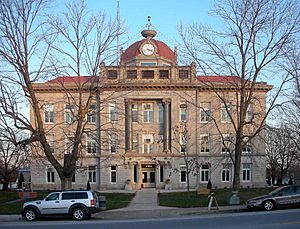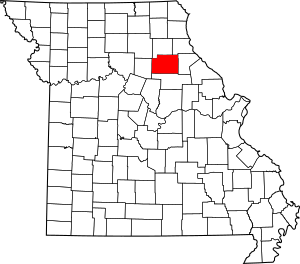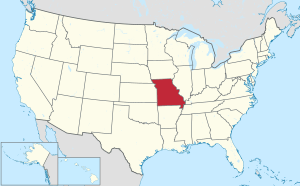Monroe County, Missouri facts for kids
Quick facts for kids
Monroe County
|
|
|---|---|

The Monroe County Courthouse in Paris
|
|

Location within the U.S. state of Missouri
|
|
 Missouri's location within the U.S. |
|
| Country | |
| State | |
| Founded | January 6, 1831 |
| Named for | James Monroe |
| Seat | Paris |
| Largest city | Monroe City |
| Area | |
| • Total | 670 sq mi (1,700 km2) |
| • Land | 648 sq mi (1,680 km2) |
| • Water | 23 sq mi (60 km2) 3.4% |
| Population
(2020)
|
|
| • Total | 8,666 |
| • Density | 13/sq mi (5/km2) |
| Time zone | UTC−6 (Central) |
| • Summer (DST) | UTC−5 (CDT) |
| Congressional district | 6th |
Monroe County is a place in northeast Missouri. It is a type of local government area called a county. In 2020, about 8,666 people lived here. The main town, or county seat, is Paris. This county is also famous as the birthplace of the well-known author, Mark Twain.
Contents
History of Monroe County
Monroe County was officially started on January 6, 1831. It was named after James Monroe. He was the fifth President of the United States.
Many early settlers came from states like Kentucky and Tennessee. They brought their traditions and ways of life with them. The county became known as part of "Little Dixie." This area had a special culture.
Geography of Monroe County
Monroe County covers a total area of 670 square miles (1,735 square kilometers). Most of this area is land, about 648 square miles (1,678 square kilometers). The rest, about 23 square miles (60 square kilometers), is water.
Neighboring Counties
Monroe County shares borders with several other counties:
- Shelby County is to the north.
- Marion County is to the northeast.
- Ralls County is to the east.
- Audrain County is to the south.
- Randolph County is to the west.
Main Roads
These are some of the important highways that go through Monroe County:
- U.S. Route 24
- U.S. Route 36
- Route 15
- Route 107
- Route 151
People of Monroe County
The number of people living in Monroe County has changed over many years.
| Historical population | |||
|---|---|---|---|
| Census | Pop. | %± | |
| 1840 | 9,505 | — | |
| 1850 | 10,541 | 10.9% | |
| 1860 | 14,785 | 40.3% | |
| 1870 | 17,149 | 16.0% | |
| 1880 | 19,071 | 11.2% | |
| 1890 | 20,790 | 9.0% | |
| 1900 | 19,716 | −5.2% | |
| 1910 | 18,304 | −7.2% | |
| 1920 | 16,414 | −10.3% | |
| 1930 | 13,466 | −18.0% | |
| 1940 | 13,195 | −2.0% | |
| 1950 | 11,314 | −14.3% | |
| 1960 | 10,688 | −5.5% | |
| 1970 | 9,542 | −10.7% | |
| 1980 | 9,716 | 1.8% | |
| 1990 | 9,104 | −6.3% | |
| 2000 | 9,311 | 2.3% | |
| 2010 | 8,840 | −5.1% | |
| 2020 | 8,666 | −2.0% | |
| U.S. Decennial Census 1790-1960 1900-1990 1990-2000 2010-2015 |
|||
2020 Census Information
In 2020, the census counted 8,666 people in Monroe County. Most people identified as White. There were also people who identified as Black or African American, Native American, Asian, Pacific Islander, or from two or more races. A small number of people identified as Hispanic or Latino.
| Race | Num. | Perc. |
|---|---|---|
| White (NH) | 7,902 | 91.2% |
| Black or African American (NH) | 177 | 2.04% |
| Native American (NH) | 32 | 0.36% |
| Asian (NH) | 31 | 0.36% |
| Pacific Islander (NH) | 1 | 0.01% |
| Other/Mixed (NH) | 364 | 4.2% |
| Hispanic or Latino | 159 | 1.83% |
Education in Monroe County
Monroe County has several schools for students of all ages.
Public Schools
- Holliday C-2 School District in Holliday
- Holliday Elementary School (Kindergarten to 8th grade)
- Madison C-3 School District in Madison
- Madison Elementary School (Pre-Kindergarten to 6th grade)
- Madison High School (7th to 12th grade)
- Middle Grove C-1 School District in Madison
- Middle Grove Elementary School (Kindergarten to 8th grade)
- Monroe City R-I School District in Monroe City
- Monroe City Elementary School (Pre-Kindergarten to 4th grade)
- Monroe City Middle School (5th to 8th grade)
- Monroe City High School (9th to 12th grade)
- Paris R-II School District in Paris
- Paris Elementary School (Pre-Kindergarten to 6th grade)
- Paris Junior High School (7th to 8th grade)
- Paris High School (9th to 12th grade)
Private Schools
- Holy Rosary School in Monroe City (Kindergarten to 9th grade) – This is a Roman Catholic school.
- Foundation for Life Christian School in Paris (Pre-Kindergarten to 12th grade) – This is a Nondenominational Christian school.
Public Libraries
- Monroe City Public Library
Communities in Monroe County
Monroe County has several towns and smaller communities.
Cities and Towns
- Florida
- Holliday
- Madison
- Monroe City (partly in Marion County and Ralls County)
- Paris (This is the county seat)
- Stoutsville
Smaller Communities (Unincorporated)
Famous People from Monroe County
- Mark Twain: A very famous American author and humorist. He was born in Monroe County. You can visit the Mark Twain Birthplace State Historic Site in Mark Twain State Park.
- Xenophon Overton Pindall: He was a member of the Arkansas House of Representatives and the Arkansas State Senate. He also served as the Acting Governor of Arkansas.
- Eli C. D. Shortridge: He was the third Governor of North Dakota from 1893 to 1895. He grew up in Monroe County.
See also
 In Spanish: Condado de Monroe (Misuri) para niños
In Spanish: Condado de Monroe (Misuri) para niños

